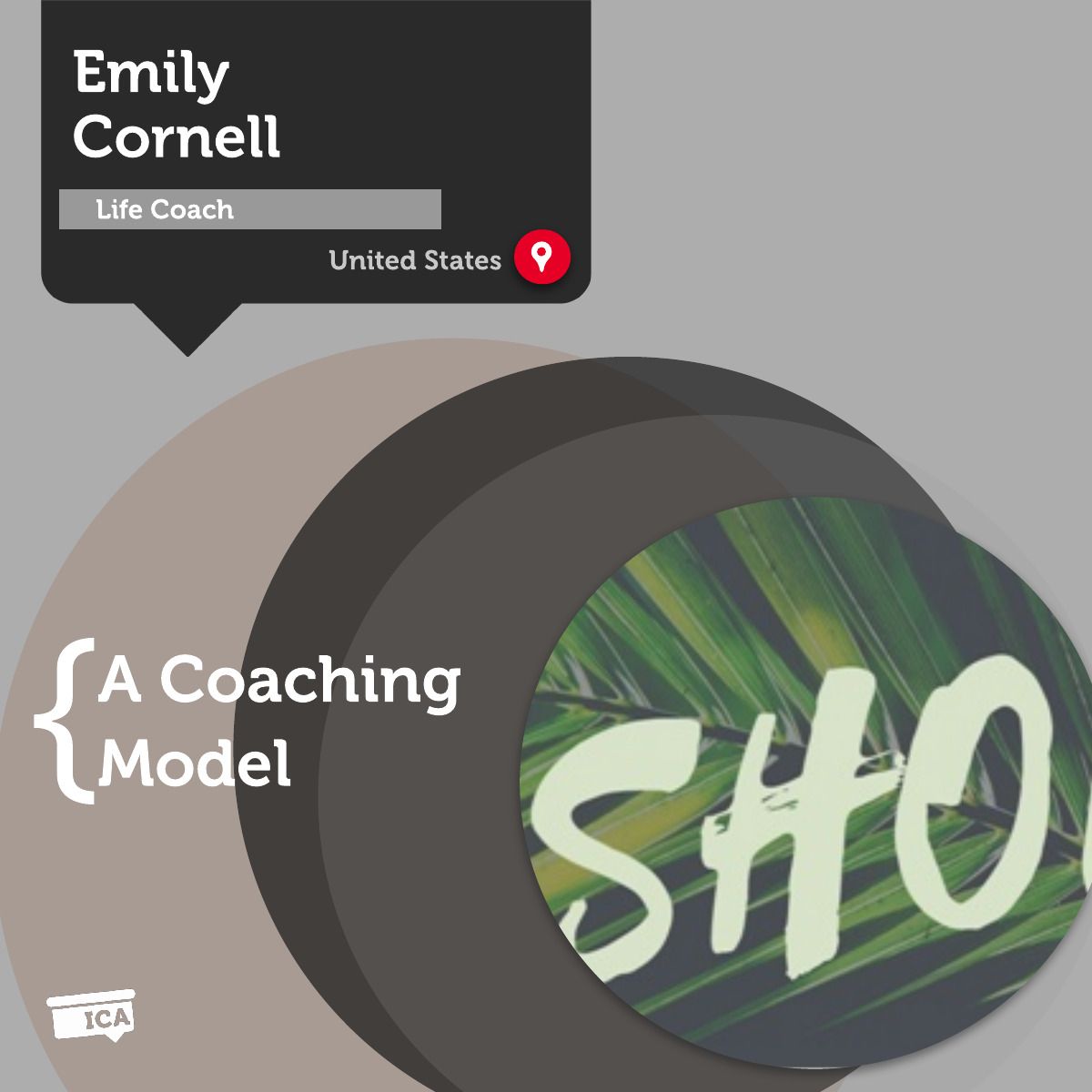A Coaching Model By Emily Cornell, Life Coach, UNITED STATES

SHOW UP: My Work and Life Experience
Who Am I?
I’m a heart-centered, purpose-driven woman who shows up to myself and my life.
But I haven’t always been.
I spent a good deal of my 20s and early 30s quite lost. From law school dropout to advertising exec to operations lead at a tech startup, I spent a lot of time gaining what felt like a disconnected career experience. And outside of work? Let’s just say I’ve been a master at breaking my own heart. From recovering from trauma and alcohol abuse to figuring out that burying myself in business and busyness wasn’t ever going to get me to “happy,” I had some bumps and bruises along the way.
I had to learn how to show up, first to myself and then to the world around me. And after I had been doing that consistently for some time, I realized I might be able to help other women do the same. So in late 2020, I took the leap I had been dreaming of and embarked on my coaching certification journey.
Throughout 2021, I’ve learned both the art and science of coaching, gained new insights into myself and my work, and developed this model, which I hope will be a valuable tool in helping my clients.
And Who Are My Clients?
They’re smart, multi-passionate women who are interested in their internal and external worlds but who are feeling either under or overwhelmed by where they find themselves right now.
They’ve been through some things and have discovered that life is, as Glennon Doyle says, “brutiful.” It’s messy and beautiful all at the same time, but they’ve figured out that they’d rather be living it than just getting through it or numbing out (however that might look: work, food, alcohol/drugs).
They’re usually pretty self-aware and have likely already done a bit of personal growth work (e.g., coaching, counseling, self-study), but they’re ready to do some more with the help of a trusted coaching partner.
The Model: SHOW UP
This model is based on my work and life experience. It also borrows some critical themes from Appreciative Inquiry, a strengths-based approach for organizational change developed at Case Western University; themes from Design Thinking, a human-centered approach to innovation; and the work of Dr. Brené Brown, research professor at the University of Houston.
It’s a six-step process that invites the client to see what’s possible, acknowledge what needs to change and use their available resources to create a plan to make meaningful changes through sustainable practice.
Get Still. How Could It Be Better? Own It. What Needs to Shift?
Use Your Resources. Practice. (Practice. Practice.)
Depending on the scope of the issue(s) the client is addressing, a single session might cover all steps, or the model might apply to an overarching coaching engagement.
The Model in Action: Theory + Practice
Get Still
In Theory:
This step may seem counterintuitive at first. But, after all, aren’t we trying to effect change?
And it’s certainly against the grain: we live in a culture that values busyness and “hustle” as well as doing over being. And while there are hopeful signs that this is changing, it will take a while.
But the power of stillness is that it can allow the client to put herself in a place ready to consciously take note of what is now, what could come, and how she might get there.
As Eckhart Tolle explains in The Power of Now: A Guide to Spiritual Enlightenment:
Space and silence are two aspects of the same thing. The same no-thing. They are an externalization of inner space and inner silence, which is stillness: the infinitely creative womb of all existence.
In Practice:
In partnership with the client, I would invite her to welcome stillness into the coaching sessions and her life.
This might look like this:
- Dedicated time within a session for stillness/quiet
- Offering resources for meditation and journaling practices
- Asking her questions such as “What happens when you sit with that [thought, feeling, idea] for a moment?”
How Could It Be Better?
In Theory:
This step is all about the client visioning the best possible outcome for herself. It’s about allowing her to get in touch with her dreams and future. And it’s rooted in a place of optimism and possibility.
In Practice:
There are many ways to dream up what could be either through dialogue or through exercises that could take place in or out of the session. For example:
- Asking questions such as “How might this be better?” “What could be possible if [X, Y, Z] were to happen?” “What would you want this to look like?”
- Vision Boarding
- Games such as “Make a World” found in Gamestorming: A Playbook For Innovators, Rulebreakers, and Changemakers
Own It
In Theory:
This part of the process is about empowerment and perspective. It’s about helping the client see her current reality, accept what has been her part in creating it, and let go of what isn’t. In my experience, that last bit can be the trickiest; clients can often get stuck feeling like the weight of responsibility rests entirely on their shoulders.
In Practice:
Exploration and exercises around what is the client’s and what’s not might look like:
- Asking questions such as “What’s in your power to change?” “What might acceptance look like here?” “How does it feel to let go of that?” “What if [X, Y, Z] doesn’t change?”
- Creating a “God” or “Worry” box: a tool for writing things down to let them go
What Needs to Shift?
In Theory:
This step is all about planning and preparation. It’s about getting incredibly clear on the future actions that will help shift the client’s reality. If the previous steps were about getting rooted in the here and now, this part of the process is all about getting ready to grow.
In Practice:
There are many ways I can support my client in figuring out what needs to shift and planning to make it happen. For example:
- Supporting the client through transforming learning and insights into action as outlined in Section D: Cultivating Learning and Growth of the ICF Core Competencies, particularly 8.1 – 8.4
- A “Momento Mori” journaling exercise
- Working through visual planning with activities like “Post the Path” and “Graphic Gameplan” (adapted from Gamestorming)
Use Your Resources
In Theory:
As I mentioned previously, my clients sometimes feel like they’re all alone in making changes. This part of the process is about helping them identify and use both their internal and external resources as well as identifying where there might be gaps that need to be filled (fulfilling Competency 8.6 in the ICF PCC Markers).
In Practice:
In addition to partnering with the client to identify both internal and external resources, I may also (with the client’s invitation) suggest other resources that she may not have identified or that were previously unavailable to her. This might include books, Ted Talks, journaling prompts, and other tools that I or my other clients have found helpful in similar situations.
Practice. (Practice. Practice.)
In Theory:
There’s a saying that change happens “sometimes quickly, sometimes slowly.” In my own experience, the most meaningful changes have been ones that have come from habit-building over time. Additionally, this step emphasizes continued practice because of my belief that progress is better than perfection (a trap that has caught not only me but my clients as well).
In Practice:
It’s also the step that’s all about creating consistency in showing up. It’s about helping my clients see and acknowledge the ways they’ve done so, course correct when they’re not where they’d like to be, and celebrate their progress and continued learning. This might look like this:
- Saving time in the session to celebrate growth or reflection that has taken place outside of sessions
- Facilitating the creation of habits for continued change
- Facilitating celebration of progress
- Co-creating rituals for closing the overarching Coaching Agreement
In Closing
This model is an artifact of a point in time for my coaching journey. It’s a framework that works now and might work in the future. But I write with the acknowledgment that my commitment to really showing up as a coach means that I must be open to my growth and the possibility that this model may, and likely will, shift over time.
Learn How to Create Your Own Coaching Model
Your Coaching Model reflects your values,
philosophies and beliefs and must communicate who you will coach
and the problems you will solve. Read more about creating your coaching model
References+ Acknowledgements
I wish to thank the staff of ICA and my peers for helping me get to the point that I could even write this. It still amazes me that I’m here, now.
Cooperrider, David L., Stavros, Jaqueline M. and Whitney, Diana K. The Appreciative Inquiry Handbook: For Leaders of Change. 2nd edn. Brunswick, OH: Crown Custom Publishing, Inc.
Brown, Brené The Gifts of Imperfection: Let Go of Who You Think You’re Supposed to Be and Embrace Who You Are… Center City, MN: Hazelden Publishing.
Brown, Brené Daring Greatly: How the Courage to Be Vulnerable Transforms the Way We Live, Love, Parent, and Lead. New York, NY: Avery, An Imprint of Penguin Random House.
Brown, Brené Braving the Wilderness: The Quest for True Belonging and the Courage to Stand Alone… New York, NY: Random House, An Imprint and Division of Penguin Random House.
Burnett, Bill, and Evans, Dave. Designing Your Life: How to Build a Well-Lived, Joyful Life. New York, NY: Alfred A. Knopf, a division of Penguin Random House LLC.
Grey, Dave, Brown, Sunni, and Macanufo, James. Gamestorming: A Playbook for Innovators, Rulebreakers, and Changemakers. Sebastopol, CA: O’Reilly Media, Inc.
Tolle, Eckhart. The Power of Now: A Guide to Spiritual Enlightenment. Novato, CA: New World Library.
